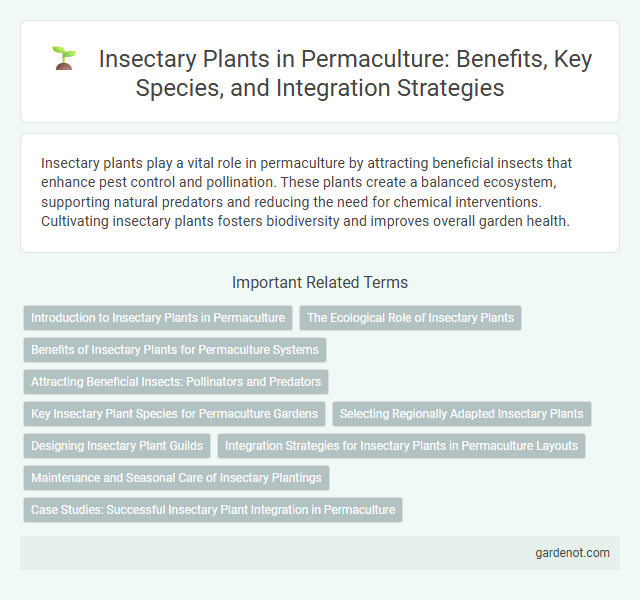Insectary plants play a vital role in permaculture by attracting beneficial insects that enhance pest control and pollination. These plants create a balanced ecosystem, supporting natural predators and reducing the need for chemical interventions. Cultivating insectary plants fosters biodiversity and improves overall garden health.
Introduction to Insectary Plants in Permaculture
Insectary plants play a crucial role in permaculture by attracting beneficial insects that aid in pest control and pollination. These plants provide essential habitats and nectar sources, enhancing biodiversity and ecosystem resilience within sustainable garden systems. Incorporating insectary plants such as yarrow, fennel, and alyssum supports natural pest management, reducing the need for chemical interventions.
The Ecological Role of Insectary Plants
Insectary plants play a crucial ecological role by attracting beneficial insects such as pollinators and natural predators of common garden pests, enhancing biodiversity within permaculture systems. These plants provide essential habitats and nectar resources that support the life cycles of predatory insects, contributing to sustainable pest management and reducing the need for chemical interventions. By improving pollination and pest control, insectary plants help maintain ecosystem balance and promote healthier plant growth and yields.
Benefits of Insectary Plants for Permaculture Systems
Insectary plants attract beneficial insects such as pollinators, predators, and parasitoids that naturally control pest populations and enhance crop yields. Their diverse flowers provide continuous nectar and pollen, improving biodiversity and ecosystem stability within permaculture systems. Incorporating insectary plants reduces the need for chemical pesticides, promoting sustainable and organic agricultural practices.
Attracting Beneficial Insects: Pollinators and Predators
Insectary plants play a crucial role in permaculture by attracting beneficial insects such as pollinators and natural predators, enhancing ecosystem health and crop yields. Key species like flowering herbs (e.g., fennel, dill) and native wildflowers provide essential nectar and habitat that support diverse insect populations. These plants improve pollination rates and biological pest control, reducing the need for chemical interventions and fostering sustainable garden ecosystems.
Key Insectary Plant Species for Permaculture Gardens
Key insectary plant species for permaculture gardens include flowering plants like alyssum, yarrow, and fennel, which attract beneficial predatory insects such as ladybugs and lacewings. Umbelliferous plants like dill and coriander provide nectar and pollen that support parasitic wasps and hoverflies vital for pest control. Incorporating diverse insectary plants enhances biodiversity and natural pest management, reducing the need for chemical interventions in sustainable garden ecosystems.
Selecting Regionally Adapted Insectary Plants
Selecting regionally adapted insectary plants enhances biodiversity and pest control by attracting native beneficial insects that are well-suited to local environmental conditions. These plants support pollinators and natural predators, improving ecosystem resilience and promoting sustainable agriculture within specific climatic zones. Choosing species native to the region ensures higher survival rates, optimal growth, and effective pest management in permaculture systems.
Designing Insectary Plant Guilds
Designing insectary plant guilds in permaculture involves selecting diverse flowering plants that provide continuous nectar and pollen sources to attract beneficial insects such as pollinators and natural predators. Incorporating native species like yarrow, fennel, and dill enhances habitat complexity and supports pest control, promoting ecosystem balance. Proper spatial arrangement and layered planting optimize microclimates and nutrient cycles, increasing the resilience and productivity of food-producing guilds.
Integration Strategies for Insectary Plants in Permaculture Layouts
Insectary plants support beneficial insect populations by providing nectar, pollen, and habitat, enhancing natural pest control within permaculture systems. Strategic placement near vegetable beds, fruit trees, and predator habitats maximizes their effectiveness, promoting biodiversity and ecosystem resilience. Incorporating diverse insectary species with staggered flowering periods ensures continuous support for pollinators and predatory insects throughout growing seasons.
Maintenance and Seasonal Care of Insectary Plantings
Maintaining insectary plantings requires regular monitoring to ensure plants remain healthy and continue attracting beneficial insects such as ladybugs, lacewings, and parasitic wasps. Seasonal care involves timely pruning, mulching, and replacing annuals to provide continuous bloom and habitat throughout the growing seasons. Proper irrigation and soil management are essential to support diverse insectary plants like dill, fennel, and yarrow, which enhance pest control and pollination in permaculture gardens.
Case Studies: Successful Insectary Plant Integration in Permaculture
Case studies of insectary plant integration in permaculture demonstrate significant improvements in pest control and crop yield by attracting beneficial insects such as ladybugs, lacewings, and parasitic wasps. Farms implementing native flowering plants like yarrow, fennel, and dill report increased pollination rates and reduced need for chemical pesticides. These examples highlight the ecological and economic benefits of incorporating insectary plants into sustainable agricultural systems.
Insectary plant Infographic

 gardenot.com
gardenot.com